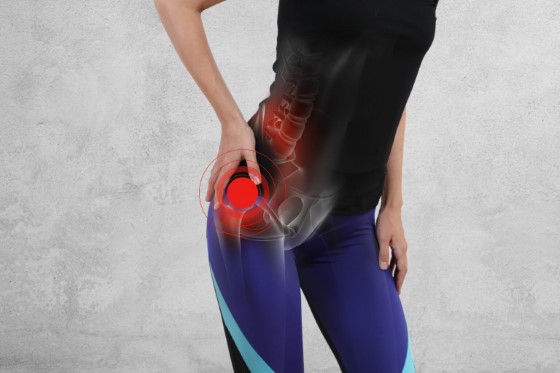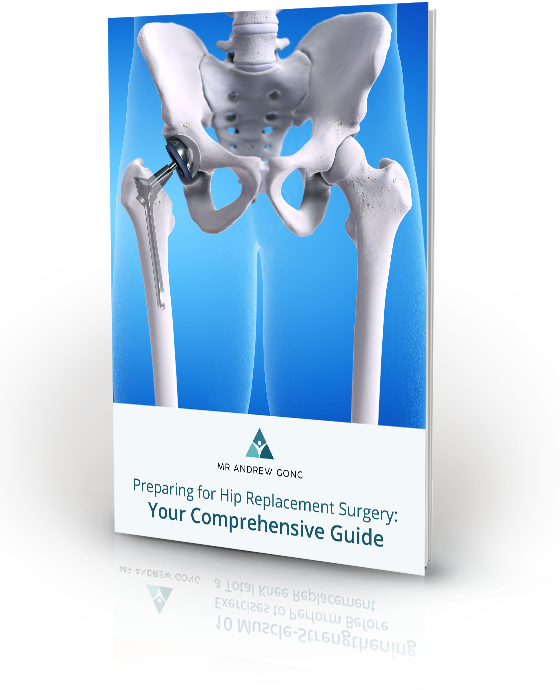Hip pain can be caused by a variety of ailments and can range from mild to debilitating. Hip pain and hip conditions can severely affect a person’s quality of life, as well as mental health
Treatments for hip issues have also come a long in recent years, with various types of approaches available that can help manage and treat these conditions.
Should you be suffering from hip pain, consider a consultation with Mr Andrew Gong, a Melbourne orthopaedic surgeon, highly skilled and experienced in successfully diagnosing and treating hip pain and hip conditions.
Preparing for Hip Replacement Surgery: Your Comprehensive Guide
Prepare yourself for a successful hip replacement surgery. From understanding the procedure and pre-surgery preparations to post-operative care and recovery exercises, this guide empowers you with the knowledge and tools needed for a smooth and confident journey.

What are hip conditions?
Hip conditions are any medical issues related to the hip joint, a ball and socket joint, which is located at the top of your thigh bone. Examples of hip conditions include hip bursitis, osteoarthritis of the hip, labral tear, avascular necrosis, slipped capital femoral epiphysis and hip fractures.
These conditions can be caused by gradual wear and tear from aging on the hip joint, from a traumatic injury or stress fracture.
Symptoms associated with a hip condition can include pain in the hip or groin area, difficulty walking or standing, swelling or tenderness in the hip area and difficulty with normal activities of daily living.

Hip pain can be a nuisance, fortunately, there are many treatments available to help manage it and keep you up and moving.

This image shows the Femoral Head, a ball and socket joint in the hip that can cause hip pain when it becomes damaged or inflamed.
Causes of hip pain
& hip conditions
There are several reasons a person may be suffering from hip pain and hip conditions, which include:
Hip injuries such as:
- Bursitis is a common cause of hip pain. It is an inflammation of the bursa, a small lubricating fluid-filled sac that helps cushion the joint. Bursitis can be caused by overuse or injury, and it is usually felt as an aching pain when moving the hip or sitting for long periods.
- Inguinal hernia is another common cause of hip pain. It occurs when a part of the intestine protrudes through a weak spot in the abdominal muscles. This causes pain in the hip or groin area and may be accompanied by a bulging lump that can be felt when the area is touched.
- Hip labral tear is a condition in which the labrum, a ring of cartilage that lines the outer part of the hip joint, is torn. This can result in causing pain in the hip or groin, and sharp pain when rotating the hip.
- Sprains are another common cause of hip pain. Sprains occur when ligaments that hold the joint together are stretched or torn. This can cause pain in the hip area and instability when walking or running.
- Tendinitis is an inflammation of the tendons, which attach muscles to bones. Tendinitis can cause pain and tenderness in the hip area, as well as a popping or snapping sensation when moving the hip.
Types of hip arthritis:
- Rheumatoid arthritis is a chronic inflammatory autoimmune disease that affects the joints of the body, including the hips. Symptoms of RA include pain, swelling, and stiffness in the joints. Treatment typically includes medications and lifestyle changes to reduce inflammation and pain.
- Osteoarthritis is the most common form of arthritis. It occurs when the cartilage in the joints wears down and causes pain, stiffness, and swelling. Treatment typically involves lifestyle modifications, medications, and physical therapy.
- Psoriatic arthritis is an inflammatory arthritis that affects both the skin and the joints. Symptoms include joint pain, swelling, and stiffness. Treatment typically involves medications, physical therapy, and lifestyle modifications.
- Septic arthritis is an infection of the joint, usually caused by bacteria or a virus. Symptoms include severe pain, swelling, and redness in the affected
Others:
- Pinched nerves, the most common symptom of a pinched nerve in the hip is pain that radiates down the leg, either along the side of the thigh or the back of the leg. This pain may be sharp or dull, and it can range from mild to severe. Other symptoms may include tingling, burning, or numbness in the affected area. In some cases, the pain may worsen with walking and cause restricted movement.
- Cancer can cause hip pain if it spreads to the hip bone or surrounding tissue. Symptoms of cancer-related hip pain include a dull or aching pain that is worse with movement and swelling or redness in the area.
- Hip dysplasia is an abnormality in which the femur (thigh bone) does not fit together with the pelvis as it should. Symptoms are a pain in the hip, limping and unequal leg lengths.

Without proper care, exercise and nutrition, our bones and bone cells can become weak and easily damaged, leading to debilitating pain.
Types of hip treatment available
The type of treatment needed for a particular hip condition will depend on the diagnosis and severity of the condition. Mr Andrew Gong is able to assist with the following treatments:
Direct Anterior Approach
for Hip Replacement
Direct anterior approach for hip replacement is a minimally invasive surgical technique for total hip replacement. This approach allows for a smaller incision and less disruption to the surrounding muscle and soft tissue. The surgeon accesses the hip joint from the front of the body without cutting muscles or tendons. This technique is associated with faster recovery and less pain post-operatively.
Total Hip Replacement
Total hip replacement (THR) is a surgical procedure in which the damaged parts of the hip joint are removed and replaced with artificial components. The goal of the procedure is to reduce pain and improve the function of the hip joint. This procedure is typically recommended for individuals who have severe hip pain and limited mobility due to arthritis or other hip joint diseases. The surgery is performed under general or regional anesthesia and typically takes one to two hours to complete.
Revision Total Hip Replacement
Revision total hip heplacement (also known as Revision Hip Arthroplasty) is a surgical procedure in which a damaged or worn-out hip joint is replaced with an artificial joint. The artificial joint is typically made of metal, plastic, or ceramic and is designed to provide a smoother, more natural movement than the original joint. This surgery is typically performed when the original joint has worn out due to arthritis, trauma, or other conditions. Revision total hip replacement is a complex procedure that requires the expertise of an experienced orthopaedic surgeon. The surgery may involve a longer recovery period and rehabilitation to restore the full range of motion.

No matter how strong the human body is, hip pain can be a reminder that it’s important to take care of ourselves and listen to our bodies.
How much does hip treatment cost
The cost of knee treatments at our Melbourne clinics is determined on a case-by-case basis. After a comprehensive evaluation, which may involve X-rays or scans, we will provide a personalised quote that outlines the cost of the treatment and surgical procedure, if applicable.
This quote will also detail the cost of hospitalisation and anesthesia, as well as any available rebates through Medicare or private health insurance.
How can Mr Andrew Gong can
help with your hip condition
With a wealth of knowledge in orthopaedic surgery, Mr Andrew Gong is a renowned fellowship-trained orthopaedic surgeon with a specialty in hip joint reconstruction.
He has extensive experience with the management of trauma, degenerative diseases, sports injuries, and complex reconstructive procedures of the shoulder, hip, and knee.
His expertise also lies in the use of modern technology and techniques, such as minimally invasive and robot-assisted surgery. He offers comprehensive medical care and rehabilitation to his patients to help them recover and return to their active lifestyles.
He is dedicated to providing the best quality of care and is highly committed to surpassing the expectations of each and every patient.

Meet Mr Andrew Gong
MBBS, FRACS (Orth), F.A.Orth.A
Renowned for his expertise and proficiency, Mr Andrew Gong is an orthopaedic surgeon in Melbourne who is highly respected and recognised as a leader in the field.
He is a distinguished fellow of the Australian Orthopaedic Association (AOA), an fellow of the Royal Australasian College of Surgeons (RACS), and an overseas affiliate member of the American Academy of Orthopaedic Surgeons.
How to schedule a consultation
If you would like to schedule an appointment to see Mr Andrew Gong, please do so via the following methods:
Our Locations
- Box HillEpworth Eastern, East Wing Tower
Level 14, Suite 14.3
25 Nelson Road, Box Hill VIC 3128
- HealesvilleGet Well Clinic
408 Maroondah Hwy
Healesville VIC 3777, Australia
- RichmondMelbourne Bone and Joint Clinic
27 Erin Street
Richmond VIC 3121, Australia
Frequently Asked Questions
What is the best treatment for severe hip pain?
The best treatment for severe hip pain will depend on the underlying cause of the pain. Common treatments include physical therapy, medications (such as non-steroidal anti-inflammatory drugs [NSAIDs]), injections, and, in some cases, surgery.
It is important to speak with your doctor to determine the best course of treatment for your particular condition.
What is the best doctor to see for hip pain?
The best doctor to see for hip pain is an orthopaedic surgeon. An orthopaedic surgeon is a medical doctor who specialises in diagnosing and treating diseases and injuries of the musculoskeletal system, which includes the bones, joints, muscles, ligaments and tendons.
What is the best alternative to hip surgery?
Physical therapy can be used as a non-surgical approach to hip pain, used to strengthen and improve the range of motion of the hip, as well as reduce pain and inflammation. Additionally, anti-inflammatory medications, injections, and lifestyle modifications can also be used to help manage hip pain.
What is the most common hip joint disorder?
Osteoarthritis, also known as “wear and tear” arthritis, is the most common type of hip disorder. The other common types of arthritis affecting hips are rheumatoid arthritis, psoriatic arthritis and post-traumatic arthritis.
Can a hip be repaired without surgery?
Yes, in some cases, a hip can be repaired without surgery. Non-surgical treatments can include physical therapy, strengthening exercises, activity modification, medications, steroid injections, and bracing.




